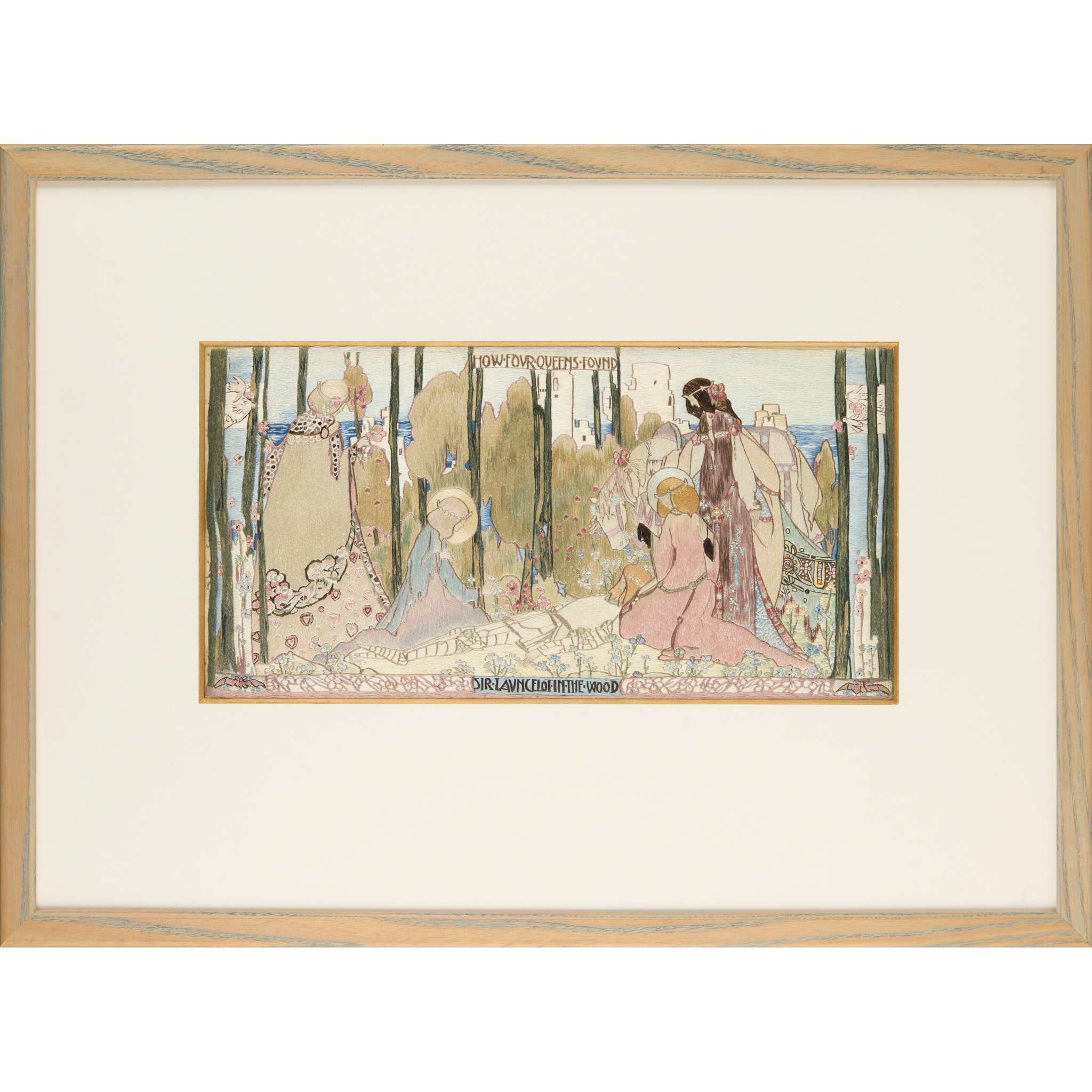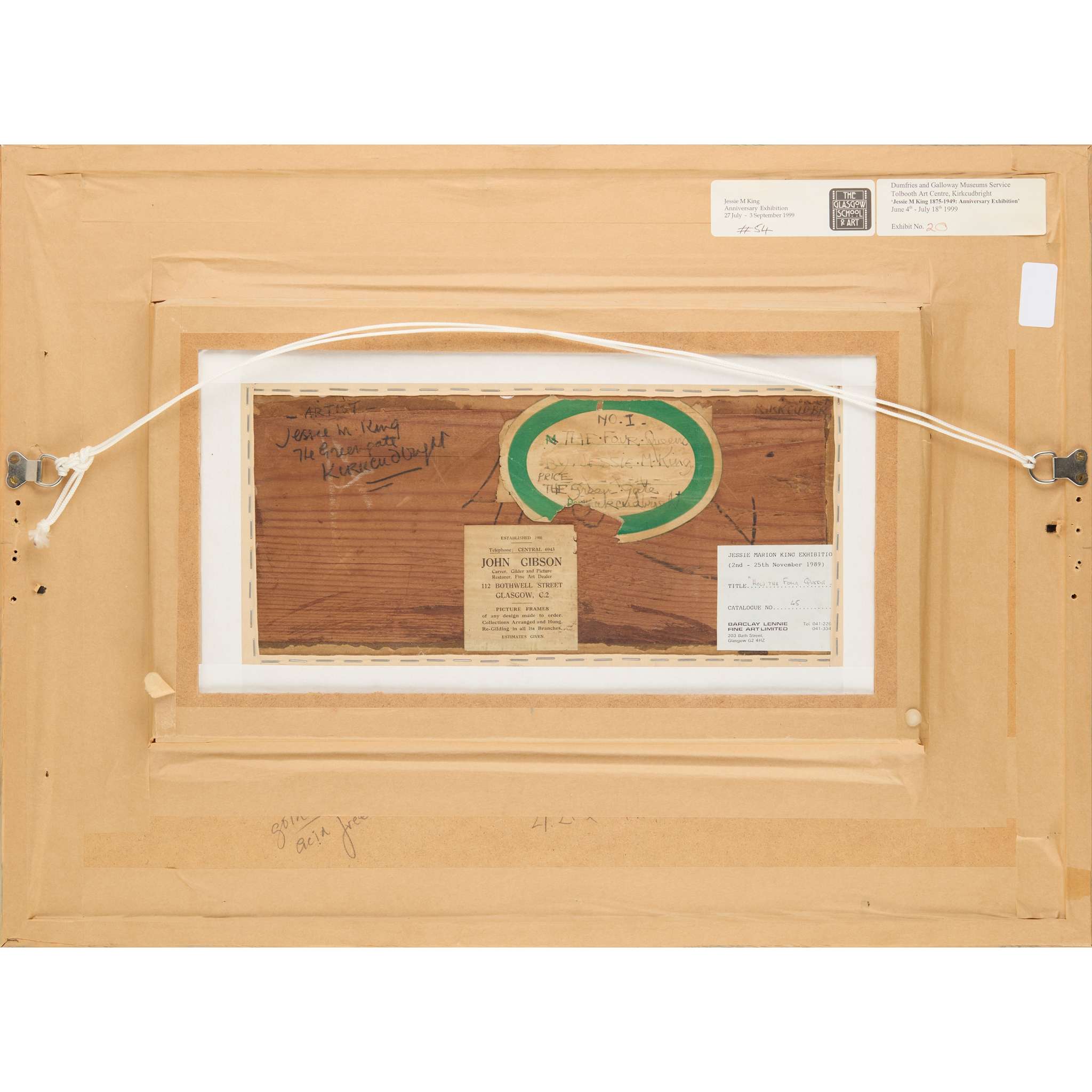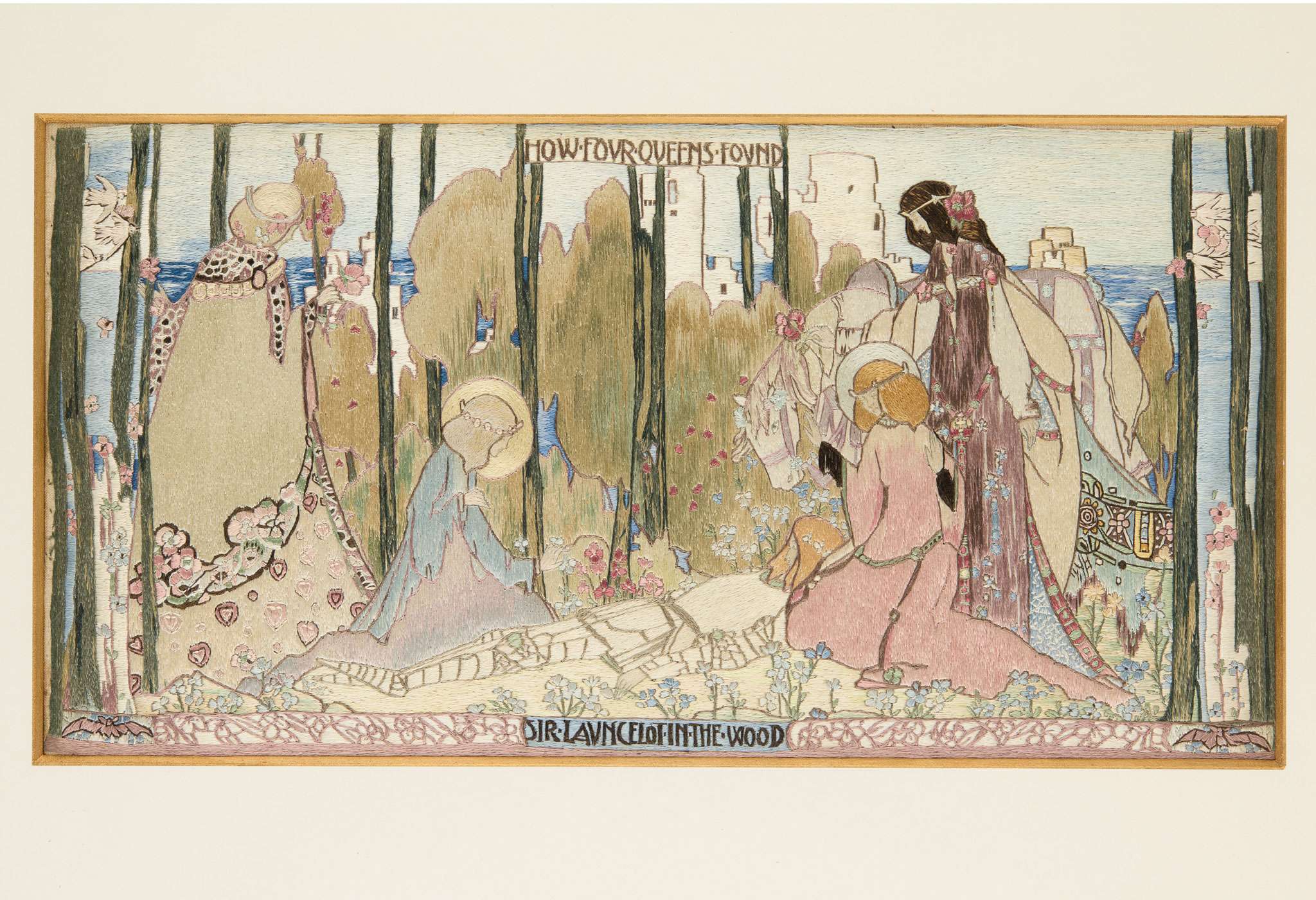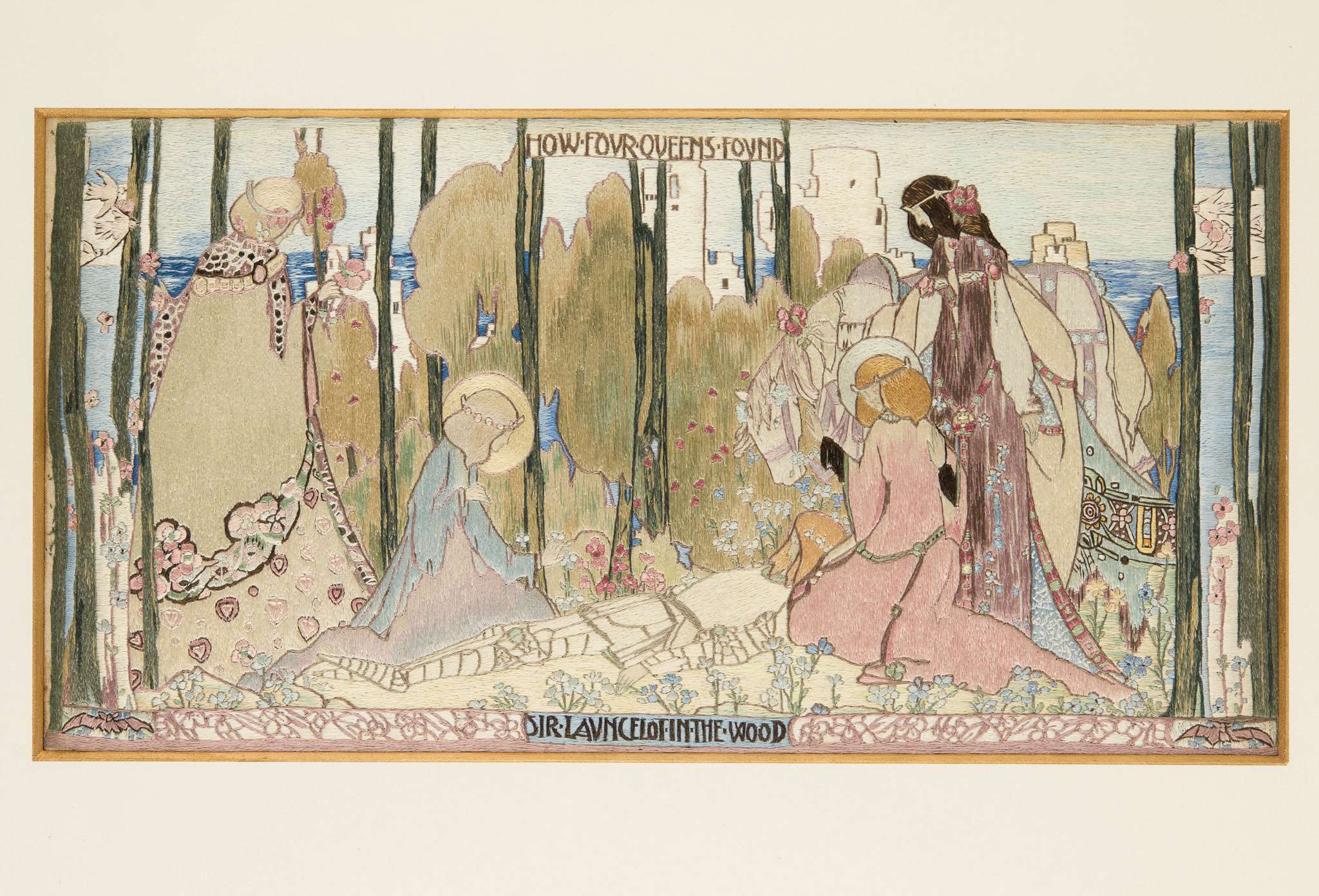278
JESSIE MARION KING (1875-1949) AND ELISE PRIOLEAU
‘HOW FOUR QUEENS FOUND SIR LANCELOT IN THE WOOD’, CIRCA 1910
coloured silks, framed
20.5cm x 41cm (frame size 48cm x 65.5cm)
Provenance: Jessie Marion King and Ernest Archibald TaylorBy descent to their daughter Merle TaylorEstate of Merle Taylor
Literature: The Studio, no. 213, December 1910, pp. 232-235, illustrated in colour p.233 White C. The Enchanted World of Jessie M King, Canongate 1989, p.33, pl.28 illustratedExhibited: Barclay Lennie Fine Art Limited, Glasgow, Jessie Marion King Exhibition 2nd-25th November 1989, no. 45 Dumfries and Galloway Museum Service Tolbooth Art Centre, Kirkcudbright, Jessie M King Anniversary Exhibition, June 4th - July 18th 1899, no. 20The Glasgow School of Art Jessie M King Anniversary Exhibition, 27 July-3 September 1999, no. 54Jessie M King’s ‘How Four Queens Found Sir Lancelot in the Wood’ employs striking design and skilful execution to illustrate a beguiling legend. Most intriguing of all however, is the artistic partnership behind its creation, a piece of the puzzle so often extinguished from the history of decorative art. The embroidery was executed around the time King and her husband E. A. Taylor were living in France. The couple moved to Paris in 1910 and founded the Shearing Atelier School of art. It can be argued that some of her finest works belong to this Paris period, including pieces considered influential to the creation of the Art Deco movement.This work marked the genesis of a collaboration between King and Paris based embroiderer Madame Elise Prioleau. Despite her French sounding name, Prioleau was descended from an ancient English family and married to a banker from South Carolina. Prior to King’s move to France, Prioleau had contacted the artist via letter. A feeling was present amongst artistic circles that contemporary embroidery lacked imaginative input and was instead producing ‘insipid and meaningless’ works, a fault of the designers rather than the embroiderers. This was a sentiment with which Prioleau agreed, hence why, on seeing King’s inspired illustrations in the Studio magazine, she suggested collaboration. The subject of the embroidery is taken from the 15th century prose work Le Morte d’Arthur by Thomas Mallory, an interpretation of the legends of King Arthur and the Knights of the Round Table. Chapter three, Book VI, Volume I describes how four fantastical queens discover Sir Lancelot resting beneath an apple tree. Having placed an enchantment, they take him to a castle where he must choose between picking a queen as his ‘paramour’ or death. Prioleau was sent a small watercolour of the design, and having traced it onto canvas, she then painstakingly worked the piece in silk threads. She was a master of her art, praised by Colin White for her use of satin stitch ‘cleverly angled across the picture like brushstrokes’, the effect being a ‘three-dimensional appearance’. Despite White’s comparison of threads with paint, E.A. Taylor in a Studio magazine article of December 1910 considers ‘How Four Queens Found Sir Lancelot in the Wood’ to be refreshingly original precisely because to him, Prioleau seems ‘at pains to avoid imitating…the pictorial painter’. The association between King and Prioleau was not limited to this piece, the duo producing works including ‘Richard Coeur de Lion’, also illustrated in the Studio. This was a fruitful and widely admired artistic partnership. ‘How Four Queens Found Sir Lancelot’ enjoyed exposure in the foremost artistic forums of the day. A full-page colour image was first reproduced in the December 1910 volume of the Studio magazine with an accompanying article discussing the state of embroidery in Paris, as well as the design featuring in ‘The Studio Year Book of Decorative Art’ the same year. Then, in 1912 the work was displayed at the Musée Galleria exhibition of embroidery, a show reported upon in the September edition of the Studio magazine. In both instances, the partnership between King and Prioleau is described in glowing terms. Whilst E. A. Taylor, King’s husband, is the author of both articles and therefore not an unbiased reporter, the publicity the embroidery received and consequently the high regard with which it must have been viewed is undeniable.
‘HOW FOUR QUEENS FOUND SIR LANCELOT IN THE WOOD’, CIRCA 1910
coloured silks, framed
20.5cm x 41cm (frame size 48cm x 65.5cm)
Provenance: Jessie Marion King and Ernest Archibald TaylorBy descent to their daughter Merle TaylorEstate of Merle Taylor
Literature: The Studio, no. 213, December 1910, pp. 232-235, illustrated in colour p.233 White C. The Enchanted World of Jessie M King, Canongate 1989, p.33, pl.28 illustratedExhibited: Barclay Lennie Fine Art Limited, Glasgow, Jessie Marion King Exhibition 2nd-25th November 1989, no. 45 Dumfries and Galloway Museum Service Tolbooth Art Centre, Kirkcudbright, Jessie M King Anniversary Exhibition, June 4th - July 18th 1899, no. 20The Glasgow School of Art Jessie M King Anniversary Exhibition, 27 July-3 September 1999, no. 54Jessie M King’s ‘How Four Queens Found Sir Lancelot in the Wood’ employs striking design and skilful execution to illustrate a beguiling legend. Most intriguing of all however, is the artistic partnership behind its creation, a piece of the puzzle so often extinguished from the history of decorative art. The embroidery was executed around the time King and her husband E. A. Taylor were living in France. The couple moved to Paris in 1910 and founded the Shearing Atelier School of art. It can be argued that some of her finest works belong to this Paris period, including pieces considered influential to the creation of the Art Deco movement.This work marked the genesis of a collaboration between King and Paris based embroiderer Madame Elise Prioleau. Despite her French sounding name, Prioleau was descended from an ancient English family and married to a banker from South Carolina. Prior to King’s move to France, Prioleau had contacted the artist via letter. A feeling was present amongst artistic circles that contemporary embroidery lacked imaginative input and was instead producing ‘insipid and meaningless’ works, a fault of the designers rather than the embroiderers. This was a sentiment with which Prioleau agreed, hence why, on seeing King’s inspired illustrations in the Studio magazine, she suggested collaboration. The subject of the embroidery is taken from the 15th century prose work Le Morte d’Arthur by Thomas Mallory, an interpretation of the legends of King Arthur and the Knights of the Round Table. Chapter three, Book VI, Volume I describes how four fantastical queens discover Sir Lancelot resting beneath an apple tree. Having placed an enchantment, they take him to a castle where he must choose between picking a queen as his ‘paramour’ or death. Prioleau was sent a small watercolour of the design, and having traced it onto canvas, she then painstakingly worked the piece in silk threads. She was a master of her art, praised by Colin White for her use of satin stitch ‘cleverly angled across the picture like brushstrokes’, the effect being a ‘three-dimensional appearance’. Despite White’s comparison of threads with paint, E.A. Taylor in a Studio magazine article of December 1910 considers ‘How Four Queens Found Sir Lancelot in the Wood’ to be refreshingly original precisely because to him, Prioleau seems ‘at pains to avoid imitating…the pictorial painter’. The association between King and Prioleau was not limited to this piece, the duo producing works including ‘Richard Coeur de Lion’, also illustrated in the Studio. This was a fruitful and widely admired artistic partnership. ‘How Four Queens Found Sir Lancelot’ enjoyed exposure in the foremost artistic forums of the day. A full-page colour image was first reproduced in the December 1910 volume of the Studio magazine with an accompanying article discussing the state of embroidery in Paris, as well as the design featuring in ‘The Studio Year Book of Decorative Art’ the same year. Then, in 1912 the work was displayed at the Musée Galleria exhibition of embroidery, a show reported upon in the September edition of the Studio magazine. In both instances, the partnership between King and Prioleau is described in glowing terms. Whilst E. A. Taylor, King’s husband, is the author of both articles and therefore not an unbiased reporter, the publicity the embroidery received and consequently the high regard with which it must have been viewed is undeniable.
DESIGN Since 1860
Sale Date(s)
Venue Address
All collections are by appointment only (this applies to both carriers and personal collections).
To book or for more information contact info@lyonandturnbull.com or telephone 0131 557 8844.
-----
UK & International - Smaller items and paintings
Art & Antique Delivery Centre
Mail Boxes Etc.
12 South Bridge
Edinburgh, EH1 1DD
T: 0131 556 6226
info@mbeedinburgh.com
Mailboxes Etc
8 Shepherd Market
Mayfair
London, W1J 7JY
Tel: 0207 491 0022
info@mbemayfair.co.uk
Mailboxes Etc
61 Praed Street
London, W2 1NS
Tel: 0207 706 3666
info@mbepaddington.co.uk
Pack & Send Edinburgh East
53 Elm Row
Leith Walk
Edinburgh, EH7 4AH
Tel: 0131 201 2244
edinburgheast@packsend.co.uk
www.packsend.co.uk/edinburgheast
UK - Larger Items
Aardvark Art Services Ltd
Tel: 01253 794 673
info@aardvarkartservices.com
John McVey Distribution Storage & Transport (UK & Ireland)
175 Waddell Street
Drumchapel
Glasgow
G5 0NA
+44(0)141 429 2015
UK & International - Larger Items
Stephen Morris Shipping
Unit 15, Ockham Drive
Greenford, Middlesex
UB6 0FD
+44(0)20 8832 2222
hannah@shipsms.co.uk
Crown Fine Art
Art Central, Union Court
20-22 Union Road
London, SW4 6JP
+44 (0)20 7732 7610
auctionteam.uk@crownww.com
Constantine Moving Services (Specialists in UK & International Shipping)
Constantine House
North Caldeen Road
Coatbridge, ML5 4EF
Tel: 01236 430 681
allanak@constantinemoving.com
A Van Man Transport
Unit 5, Benridge Park
Holyrood Close, Creekmoor
Poole, Dorset, BH17 7BD
Tel: 01202 600 012
office@avmt.co.uk
Gallery Support Group
Unit 4, 89 Manor Farm Road
Wembley
London, HA0 1BA
Tel: 020 305 307 53
info@gallerysupportgroup.com
Important Information
BUYER'S PREMIUM
The buyer shall pay the hammer price together with a premium, at the following rate, thereon.
26% up to £20,000
25% from £20,001 to £500,000
20% thereafter
VAT will be charged on the premium at the rate imposed by law (see our Conditions of Sale at the back of this catalogue).
ADDITIONAL VAT
† VAT at the standard rate payable on the hammer price
‡ Reduced rate of 5% import VAT payable on the hammer price
[Ω] Standard rate of import VAT on the hammer price
Lots affixed with ‡ or [Ω] symbols may be subject to further regulations upon export /import, please see Conditions of Sale for Buyers Section D.2.
No VAT is payable on the hammer price or premium for books bought at auction
REGISTRATION
All potential buyers must register prior to placing a bid. Paddle registration must be completed in advance of the sale day. Please note that all first-time, and those returning after an extended period, bidders at Lyon & Turnbull will be asked to supply the following documents in order to facilitate registration:
1 – Government issued photo ID (Passport/Driving licence)
2 – Proof of address (utility bill/bank statement).
By registering for the sale, the buyer acknowledges that he or she has read, understood and accepted our Conditions of Sale.
ARTIST’S RESALE ROYALTY (DROIT DE SUITE)
§ indicates works which may be subject to the Droit de Suite or Artist’s Resale Right, which took effect in the United Kingdom on 14th February 2006. We are required to collect a royalty payment for all qualifying works of art. Under new legislation which came into effect on 1st January 2012 this applies to living artists and artists who have died in the last 70 years. This royalty will be charged to the Buyer on the Hammer Price and in addition to the Buyer’s Premium. It will not apply to works where the Hammer Price is less than £1,000. The charge for works of art sold at and above £1,000 and below £50,000 is 4%. For items selling above £50,000, charges are calculated on a sliding scale. All royalty charges are paid to the Design and Artists Copyright Society (‘DACS’) and no handling costs or additional fees are retained by the Auctioneer. Resale royalties are not subject to VAT.
More information on Droit de Suite is available at www.dacs.org.uk
REMOVAL OF PURCHASES
Responsibility for packing, shipping and insurance shall be exclusively that of the purchaser. See Collections & Storage section for more info specific to this particular auction.
CATALOGUE DESCRIPTIONS
All item descriptions, dimensions and estimates are provided for guidance only. It is the buyer’s responsibility to inspect all lots prior to bidding to ensure that the condition is to their satisfaction. Our specialists will be happy to prepare condition reports and additional images. These are for guidance only and all lots are sold ‘as found’, as per our Conditions of Sale.
IMPORT/EXPORT
Prospective buyers are advised that several countries prohibit the importation of property containing materials from endangered species, including but not limited to; rosewood, rhino horn, ivory, coral and tortoiseshell. Accordingly, prospective buyers should familiarise themselves with all relevant customs regulations prior to bidding if they intend to import lots to another country. It is the buyer’s sole responsibility to obtain any relevant export or import licence. The denial of any licence or any delay in obtaining licences shall neither justify the recession of any sale nor any delay in making full payment for the lot.
ENDANGERED SPECIES
Please be aware that lots marked with the symbol Y contain material which may be subject to CITES regulations when exporting outside Great Britain. For more information visit https://www.defra.gov.uk/ahvla-en/imports-exports/cites
Terms & Conditions
UK - Conditions Of Sale For Buyers
These Conditions of Sale and the Saleroom Notices as well as specific Catalogue terms, set out the terms on which we offer the Lots listed in this Catalogue for sale. By registering to bid and/or by bidding at auction You agree to these terms, we recommend that You read them carefully before doing so. You will find a list of definitions and a glossary at the end providing explanations for the meanings of the words and expressions used.
Special terms may be used in Catalogue descriptions of particular classes of items (Books, Jewellery, Paintings, Guns, Firearms, etc.) in which case the descriptions must be interpreted in accordance with any glossary appearing in the Catalogue. These notices and terms will also form part of our terms and conditions of sales.
In these Conditions the words “Us”, “Our”, “We” etc. refers to Lyon & Turnbull Ltd, the singular includes the plural and vice versa as appropriate. “You”, “Your” means the Buyer.
Lyon & Turnbull Ltd. acts as agent for the Seller. On occasion where Lyon & Turnbull Ltd. own a lot in part or full the property will be identified in the catalogue with the symbol (















